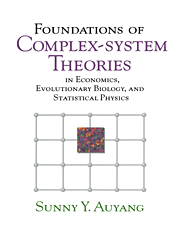Book contents
- Frontmatter
- Contents
- Preface
- 1 Introduction
- PART I EQUILIBRIUM
- 2 Theories of Composite Systems
- 3 Individuals: Constituents and Systems
- 4 Situated Individuals and the Situation
- 5 Interacting Individuals and Collective Phenomena
- 6 Composite Individuals and Emergent Characters
- PART II DYNAMICS
- Notes
- Bibliography
- Name Index
- Subject Index
6 - Composite Individuals and Emergent Characters
Published online by Cambridge University Press: 11 May 2010
- Frontmatter
- Contents
- Preface
- 1 Introduction
- PART I EQUILIBRIUM
- 2 Theories of Composite Systems
- 3 Individuals: Constituents and Systems
- 4 Situated Individuals and the Situation
- 5 Interacting Individuals and Collective Phenomena
- 6 Composite Individuals and Emergent Characters
- PART II DYNAMICS
- Notes
- Bibliography
- Name Index
- Subject Index
Summary
Emergent Characters of the System as a Whole
So far we have examined models in which large composite systems are microanalyzed into uncoupled or weakly coupled entities. In some models, the entities are modified constituents that have internalized much of their former interaction; in others, they are collectives engaging the organized behaviors of many constituents. The models focus on finding the characters and behaviors of the entities that, once known, can be readily aggregated to yield system characters, for the weak coupling among the entities can be neglected in a first approximation. Thus we can crudely view a system in these models as the sum of its parts, although the parts are specialized to it and differ from the familiar constituents of its smaller counterparts.
Not all phenomena are microanalyzable by modularization. Phenomena such as freezing and evaporation, in which the entire structure of a system changes, would be totally obscured from the viewpoint of the parts. Here the correlation among the constituents is too strong and coherent to be swept under the cloaks of individual modules, whatever they are. In such thoroughly interconnected systems, the effects of a slight perturbation on a few constituents can propagate unhampered and produce large systemwide changes. Consequently, the behaviors of these systems are more multifarious, unstable, and surprising. They are often called emergent properties and processes. Emergent characters are most interesting and yet most controversial, for they are most difficult to treat theoretically and incur the wrath of some revisionary philosophies.
- Type
- Chapter
- Information
- Foundations of Complex-system TheoriesIn Economics, Evolutionary Biology, and Statistical Physics, pp. 173 - 210Publisher: Cambridge University PressPrint publication year: 1998



